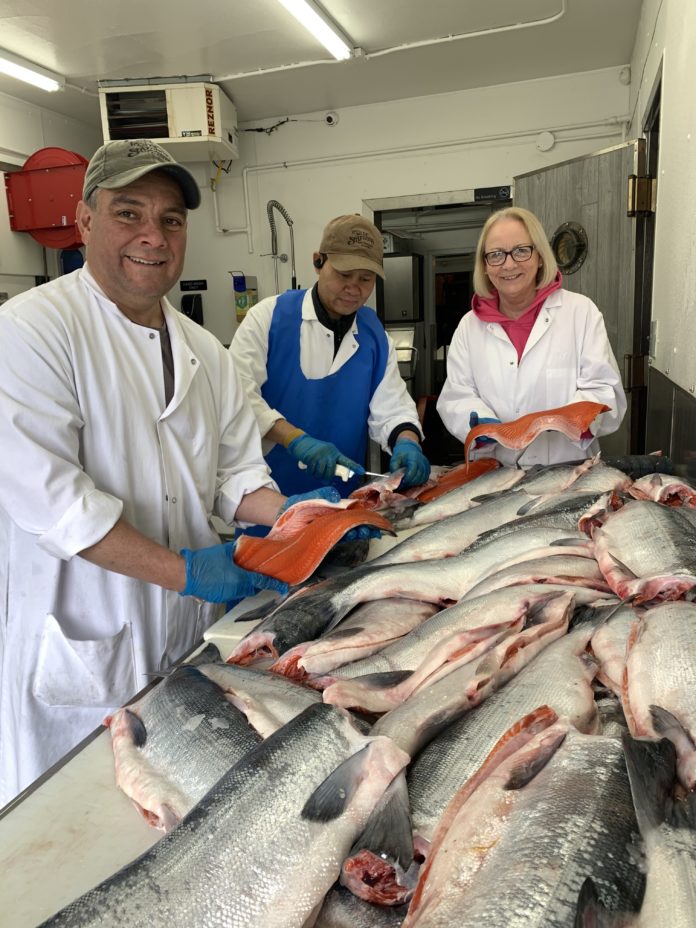
Copper River wild salmon catches are still climbing, in the wake of two closures, and the harvest from Monday’s 36-hour opener still to be counted.
As of Tuesday, the Alaska Department of Fish and Game (ADF&G) calculated the total preliminary Copper River district catch at 521,492 fish, including 495,590 sockeyes, 16,731 chum, 9,012 Chinook, 108 pink and 51 coho salmon.
The June 22 Copper River opener, the last one for which harvests were totaled, saw 244 deliveries from harvesters to processors, bringing in 50,443 sockeyes, 856 chum, 383 kings, 81 pink and 50 cohos.
Area wide Prince William Sound commercial fishing districts have caught an estimated nearly 1.7 million salmon through Tuesday, including 919,637 chum, 739,571 sockeye, 19,343 pink, 9,294 Chinook and 79 coho salmon.
The largest area catch of sockeyes outside of the Cordova District was 173,262 reds in the Eshamy Bay drift gillnet fishery.
The largest area chum catch to date has been in the Montague drift gillnet district, with an estimated harvest of 583,441 chums, followed by 212,935 chums in the Coghill drift gillnet fishery.
ADF&G meanwhile put the statewide commercial salmon preliminary harvest at nearly 5.3 million fish, including 1,039,000 sockeyes, 2,187,000 chum, 182,000 pink and 30,000 Chinook.
“The overall Alaska commercial salmon harvest is in line with 2022, with some variation among species,” noted Sam Friedman, a seafood consultant with McKinley Research Group LLC, in Anchorage, which compiles in season commercial salmon fishing reports for the Alaska Seafood Marketing Institute.
“Early season keta harvest volumes are up (+162%), while early sockeye and Chinook harvests are down through the end of Statistical Week 25, which ended June 24 this year, but was June 18 in 2022. Pink salmon harvests are just starting to come in and the first expected coho harvests are still weeks away,” Friedman said.
“Early season keta harvest was driven by the Prince William Sound region, where the harvest is up 250% from 2022,” he said. “The keta harvest is down 35% in the Alaska Peninsula. While the statewide keta catch is up, it is in line with the five-year average. For sockeye salmon, the Alaska Peninsula catch is down 62% from 2022, bringing the overall species year-over-year trend to -15%. Much more will be known about Alaska’s sockeye salmon harvest in the next few weeks as Bristol Bay fishing ramps up.”
Friedman also noted that last week the Ninth Circuit U.S. Court of Appeals halted implementation of a lower court ruling in a lawsuit brought by the Wild Fish Conservancy in Seattle. That ruling would have prevented the opening of the Southeast Alaska summer Chinook troll fishery from opening on July 1. That fishery will now proceed as normal, Friedman said, with the statewide Chinook projection raised by 100,000 fish to 242,000 kings.
Weekly harvest data compiled by ADF&G showed the Bristol Bay commercial sockeye salmon fishery is off to a robust start, with a year-to-date harvest of 1,890 metric tons up 480% from 326 metric tons in 2022. In the Alaska Peninsula, the year-to-date harvest of 1,966 metric tons of sockeyes was down 62% from 5,240 metric tons in 2022.
ADF&G data showed that the overall Prince William Sound Chinook harvest was down 22%, from 55 metric tons year-to-date in 2022 to 43 metric tons in 2023. Kodiak area sockeye harvest was also down 29%, from 539 metric tons in 2022 to 382 metric tons as of Tuesday.
Pink salmon harvests were up 200% for Kodiak, from 14 metric tons year-to-date in 2021 to 42 metric tons as of this week. With pink salmon harvests more robust in odd years, ADF&G calculates those harvests differently than for other wild salmon.
In the Alaska Peninsula, the pink salmon harvest dropped 93% year-to-date, from 2,667 metric tons in 2021 to 180 metric tons in 2023, while the keta salmon harvest was down 35%, from 624 metric tons in 2022 to 405 metric tons in 2023 year-to-date.
Prices for Copper River wild sockeyes and Chinooks have not dropped at Seattle’s famed Pike Place Fish Market, given the steady demand for those oil-rich fish. Pike Place market prices range from $549.99 for whole Copper River kings and $99.99 for whole Copper River sockeyes, to $29.99 a pound for Copper River sockeye fillets and $79.99 a pound for fillets of Copper River kings.
A significant amount of sockeye salmon harvested in the summer of 2022 is still being sold in retail shops and elsewhere, including Carrs-Safeway seafood counters in Anchorage, where it was priced this week at $15.99 a pound.
10th & M Seafoods, a popular Anchorage seafood market, was offering fillets of Prince William Sound sockeye for $12.95 a pound and fillets of Southeast Alaska kings for $25.95 a pound, while FishEx, an online purveyor of Alaska seafood, had premium portions of Copper River sockeyes for $49.46 a pound, down from $54.95 a pound. Shipping charges are extra at all of these shops.
Costco stores in Anchorage had fresh fillets of wild Alaska sockeyes at $11.99 a pound, while at Fred Meyer supermarkets the price was $10.99 a pound. Shoppers with Carrs membership cards were able to purchase fillets of Copper River salmon for $10.99 a pound, a deal that ended on Tuesday.





